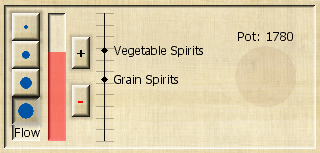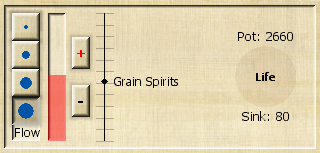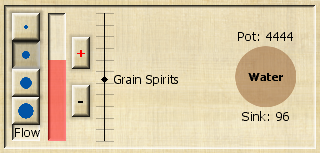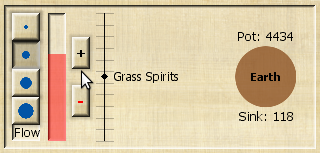The Wiki for Tale 4 is in read-only mode and is available for archival and reference purposes only. Please visit the current Tale 11 Wiki in the meantime.
If you have any issues with this Wiki, please post in #wiki-editing on Discord or contact Brad in-game.
User:Numaris/Grass Spirits
Grass Spirits can be a bit tricky. Along with Fruit Spirits, they are not directly produced by any alcohol that we know of. They must be made by mixing a little bit of Vegetable Spirits into a batch of Grain Spirits. Making it even trickier, only the outermost bit of the Grain/Vegetable regions can be used, lest the spirits turn Grey before reaching the Grass region.
Requirements
- High Tannin Wine. Provides the Grain Spirits that make up most of the mixture.
- Residual Sugar Wine. You can use a wine specifically made for the purpose, or you might be able to get away with using any old wine that had some residual sugar, depending on how many spirits you're making.
- Alembic. There are public Alembics out there if you don't otherwise have access to one.
- Charcoal. 100-200 to be safe, but you probably won't use nearly that much.
- Patience. This is the big one... it's a tedious process. Don't take shortcuts.
The Dead Zone
There are two zones of spirits that wines can produce: the high-temperature region (Vegetable, Mineral, and Fish Spirits) provided by residual sugars, and the low-temperature region (Wood, Worm, and Grain Spirits) provided by tannins. We're going to be spending most of our time in the dead zone in between, where Grass and Fruits spirits lurk in the shadows.
This image shows the very top pixel of Grain Spirits, and the very bottom pixel of Vegetable Spirits. Take special note of the two tick-marks between them... those are going to be the set points that define how we work the Alembic.
Phase 1: Grain Spirits
The first thing we need to do is build ourselves up a good stock of very pure Grain spirits.
- Load your Alembic with charcoal and hit the + button to begin warming it up.
- Open the flow up nice and wide... this is already slow going, don't make it worse on yourself.
- Once the temperature gauge gets above the Grain region (see above photo), add your high-tannin wine.
- Use the next tick-mark above the top of the Grain region as your set point. When the temperature is at or above this mark, make the temperature fall. If the temperature is below this mark, make the temperature rise even if you're already well above the Grain region.
This is where the patience comes in. You're going to spend a lot of ticks outside the Grain region doing nothing, but it's very important that you don't give the temperature an opportunity to drop more than one or two pixels into the Grain region. Don't be tempted to cheat a few pixels lower. You don't want to have to do this all over again.
Continue until you have as much Grain Spirits as you want. You'll get about 10-15% more from the Vegetable Spirits (also, remember that there are 32 Grain Spirits in the pipeline that will work their way through).
Phase 2: Adding the Vegetable Spirits
Once you're finished with the Grain Spirits, you'll have something like this, where I have 112 Grain Spirits of Life (80 in the sink, 32 in the line):
- Make sure the temperature is on its way up and add your high-sugar wine.
- Throttle down your flow if necessary. Estimate that you'll need at least 10% the amount of Vegetable spirits as you have Grain spirits. In the photo above, I estimated that I'd need around 12. I could use the second largest flow on the Alembic (4db per tick), but I decided to be a little more patient and use the next one up (2db per tick). If you're doing a lot of spirits at once, you can keep the flow full open at first, but be sure to keep track of the numbers and throttle it down when you get close.
- In the same way that you previously used the tick-mark above the Grain region as your set point, now use the tick-mark just below the Vegetable region as your set point, as seen here:
When the temperature gauge is at or below the tick-mark, let the temperature rise. When it is above the mark, make it fall. You'll see the purity drop real fast once you start hitting the Vegetable region. Don't panic. It slows down once you get into Water and Earth.
Again, patience is the name of the game. Keep plinking away at it, a few debens at a time, until the dot finally rises up into the Grass region.
Enjoy!




